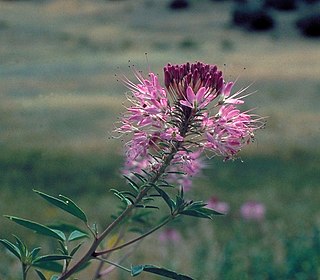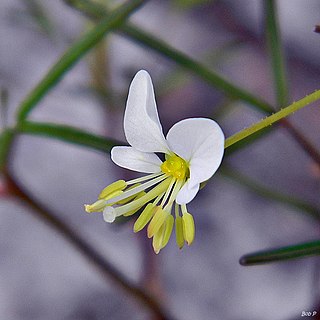
The Brassicales are an order of flowering plants, belonging to the eurosids II group of dicotyledons under the APG II system. One character common to many members of the order is the production of glucosinolate compounds. Most systems of classification have included this order, although sometimes under the name Capparales.

Cleomella serrulata, commonly known as Rocky Mountain beeplant/beeweed, stinking-clover, bee spider-flower, skunk weed, Navajo spinach, and guaco, is a species of annual plant in the genus Cleomella. Many species of insects are attracted to it, especially bees, which helps in the pollination of nearby plants. It is native to southern Canada and the western and central United States. The plant has often been used for food, to make dyes for paint, and as a treatment in traditional medicine.

Cleome is a genus of flowering plants in the family Cleomaceae, commonly known as spider flowers, spider plants, spider weeds, or bee plants. Previously, it had been placed in the family Capparaceae, until DNA studies found the Cleomaceae genera to be more closely related to the Brassicaceae than the Capparaceae. Cleome and clammyweed can sometimes be confused.

Cleomella is a genus of flowering plants. It includes 22 species of native to North America, ranging from southern Mexico through the western and central United States to western and central Canada. Like their relatives, the cleomes, plants of this genus have traditionally been included in the caper family Capparaceae but have recently been moved into a new family, Cleomaceae. Cleomella are annual wildflowers native to the dry and desert regions of western North America. They are similar to cleomes in appearance. They are erect and branching with leaves divided into three leaflets and inflorescences of yellow flowers with long stamens. Cleomella species are known commonly as stinkweeds or simply cleomellas.

Cleome gynandra is a species of Cleome that is used as a leaf vegetable. It is known by many common names including Shona cabbage, African cabbage, spiderwisp, cat's whiskers, and stinkweed. It is an annual wildflower native to Africa but has become widespread in many tropical and sub-tropical parts of the world.

Cleomella platycarpa is a species of flowering plant in the cleome family known by the common names golden bee plant and golden spiderflower. It is native to the western United States from northeastern California to Idaho, including the Modoc Plateau, where it grows on clay and volcanic soils in the sagebrush. It is an annual herb branching at the base into several erect stems up to about 60 centimetres (24 in) tall. The stems are green tinted with purple, coated densely in glandular hairs, and lined with many leaves. Each leaf is divided into three small leaflets. The top of each stem is occupied by a raceme of many flowers. Each flower has generally four yellow sepals and four yellow petals around a center of many yellow stamens. The fruit is a flat, hairy capsule up to 2.5 centimeters long which hangs on the long, remaining flower receptacle. Found between 800–1200m.

Stangeia xerodes is a moth of the family Pterophoridae that is found in most of mainland Australia, the Ryukyu Islands, Java and Sri Lanka.
Colotis pleione, the orange patch tip, is a butterfly in the family Pieridae. It is found in Arabia, Ethiopia, Somalia, Kenya, Sudan and Chad. The habitat consists of very dry savanna to sub-deserts.

Cleome rutidosperma, commonly known as fringed spider flower or purple cleome, is a species of flowering plant in the genus Cleome of the family Cleomaceae, native to tropical Africa. This species is an invasive weed throughout most lowland wet tropical areas of Asia and Australia. It is a very common weed of lawns.

Cleome maculata is a species of cleome that is native to southern Africa, where it occurs in sandy soils, especially in rocky habitats, and on slopes. It is a mostly annual plant, which is found in highveld regions of medium rainfall in South Africa, Botswana and Namibia. It is an erect and simple or branching plant, usually less than a foot tall, with sparse leaves. The linear leaflets are three to five compound. Two of the up-curved, mauve flower petals have a yellow mark at their center, which is bordered with dark purple. The long, up-curved stamens are tipped with bluish, knobby anthers. The fruit is a linear capsule. The species is a pioneer plant that may become a weed.

Cleome viscosa, the Asian spiderflower or tick weed is an annual herb that grows up to a meter high. It belongs to the family Cleomaceae. It is considered an invasive species and is widely distributed in warm and humid habitats across the Americas, Africa and Asia, and in Australia. It is commonly found during the rainy season.

Cleome angulata, the elegant spider-flower, is a species of flowering plant in the family Cleomaceae. It is an annual native to western India and to Java. In western India it is found in the Konkan region of Maharashtra.
Cleome cleomoides, commonly known as Justago, is a species of plant in the Cleomaceae family and is found in Western Australia.
Cleome kenneallyi is a species of plant in the Cleomaceae family and is found in Western Australia.
Cleome oxalidea is a species of plant in the Cleomaceae family and is found in Western Australia.
Cleome tetrandra is a species of plant in the Cleomaceae family and is found in Western Australia.
Cleome uncifera is a species of plant in the Cleomaceae family and is found in Western Australia.
Bossiaea arenitensis , commonly known as sandstone winged pea, is a species of flowering plant in the pea family Fabaceae and is endemic to the Kimberley region of Western Australia. It is an erect, spindly shrub with winged stems, winged cladodes, scale-like leaves and yellow, red and burgundy-coloured flowers.

Polansia tenuifolia is a species of flowering plant in the family Cleomaceae. It grows in Florida. It is known by the common names pineland catchfly and slender-leaf clammyweed. It is synonymous with Aldenella tenuifolia, Cleome aldanella, Cleome tenuifolia, and Jacksonia tenuifolia. It is an annual.











